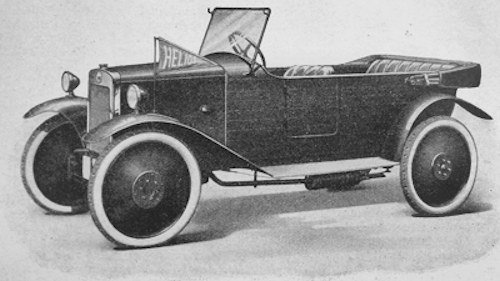Helios-Automobilbau AG
Automotive manufacturer Cologne - Ehrenfeld Germany from 1903 to 1929

The Helios AG an electric light and telegraph plant was founded in 1882, And also built cars and commercial vehicles from 1903 to 1906 and later again in the 1920s.
History
The Helios AG companies from the pioneering days of Electrical Engineering. The company headquarters and production site were the then industrial city of Ehrenfeld, which was incorporated into Cologne in 1888.
Helios acquired in 1903 from the motor truck factory Rudolf Hagen & Cie. GmbH from Cologne patents and manufacturing facilities for passenger cars until 1909.Again later in the 1920s car were built.
The former administration building Helioshaus, the former production halls as well as the former company landmark, a 44-meter-high lighthouse for experiments and demonstrations.
In 1903 A car model with two-cylinder engine and 10 hp and two models with four-cylinder engine and 20 or 40 hp were produced. In addition, trucks and electric buses and trams with electric drives appeared they were built by 1906, the Type SP trucks with 2 or 4-cylinder engines between 10,20 and 40 hp were being produced Licenses to build vehicles were granted to England and France. 1906 ended the first motor vehicle production.
in 1923, that Delfosse and Kölner Industriewerke GmbH founded Helios Automobilbau AG After the Cologne-based industrialist and automobile pioneer Arthur Delfosse had taken over parts of the electrical company Helios, they began to produce automobiles under the Helios brand.
The technical direction was taken over by his son Curt Delfosse. Helios developed and built a small cars with water cooling, cardan gear, solid chassis frame types H2 and H3 were created with two seats and a two-cylinder boxer engine with 972 cc four-stroke displacement, whose power was transmitted via a cardan shaft to the rear wheels. The Small cars of only 3 meters overall length with 8 to 9 hp engine power and a weight of 350-380 kg.Maximum speed: depending on the engine 50 or 60 km per hour the fuel consumption: depending on the engine 3 or 3.5 kg per 100 km.
The driver and one or two passengers sat in tandem. The automobiles were advertised as cheapest German quality cars to buy at of 2950 marks. By 1928 vehicles of the Helios types H4 with 16 hp and H1 or H1D with 36 or 32 hp All parts are interchangeable.
Technical
-
Helios cars Technical details and specifications (1923-1929)
TRANSMISSION DRIVE LINE:
power transmission: through cardan gearbox
Four speeds, three forward, 1 reverse Gearshift
Clutch: Large cone clutch, operated by foot pedal
Front axle: with fixed hubs
Ball circuit directly on the gearbox (internal circuit)ENGINE:
Cooling: Thermosyphon water cooling
Ignition Electric dynamo lightingBRAKES:
hand and foot brake (internal shoe brake, dust-proof encapsulated)
handbrake lockable,CHASSIS:
frame: U-profile made of sheet steel,SUSPENSION:
front and rear strong, quarter-elliptical cantilever springs,WHEELS TYRES:
detachable sheet steel disc wheels
26 X 3 tires.
DIMENSIONS AND WEIGHT:
Track width: 1100 mm
Wheelbase: 2200 mm
Overall length of the car: approx. 3000 mm,
Overall width approx. 1200 mm
Overall height including screen approx. 1500 mm ,
Weight: depending on engine and body 350 kg to 380 kg .
